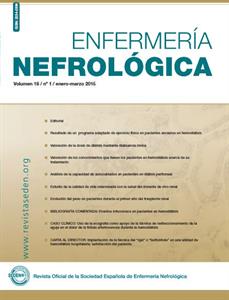Contenido del artículo principal
Resumen
Es indudable que el acceso vascular no sólo es uno de los elementos clave para poder llevar a cabo el tratamiento sustitutivo renal con hemodiálisis sino que representa una de las principales causas de morbilidad, hospitalización y coste en los enfermos tratados con esta técnica. La fístula arteriovenosa sigue siendo el acceso vascular de elección. El hecho de que el paciente acuda al menos tres veces por semana para el tratamiento, convierte a la técnica de punción de la fístula en uno de los factores más relevantes que influyen en su supervivencia y, por tanto, en la calidad de vida del paciente1,2. Los problemas relacionados con la técnica incluyen un gran abanico de contratiempos (canalización dificultosa, presiones venosas elevadas, elevada recirculación, bajo flujo, presencia y aspiración de coágulos, hemostasia prolongada, etc.) siendo el dolor un evento muy prevalente3. A pesar de que son muchos los estudios de calidad de vida relacionada con la salud que analizan el dolor del paciente en hemodiálisis, en pocas ocasiones se hace referencia al acceso vascular como variable independiente y, los que lo hacen, únicamente hacen referencia al dolor crónico o al momento de la punción4. Sin embargo, uno de los eventos que mayor ansiedad y disconfort genera al paciente es el dolor producido durante la sesión relacionado con la posición de las agujas de punción. Por tanto, el objetivo de este estudio es presentar un caso donde se describe el uso de los ultrasonidos para el manejo del dolor de la fistula arteriovenosa
Palabras clave
Detalles del artículo
Aviso de derechos de autor/a
© Los autores ceden de forma no exclusiva los derechos de explotación de los trabajos publicados y consiente en que su uso y distribución se realice con la Licencia Creative Commons Atribución - No comercial 4.0 Internacional (CC BY-NC 4.0). Puede consultar desde aquí la versión informativa y el texto legal de la licencia. Esta circunstancia ha de hacerse constar expresamente de esta forma cuando sea necesario.




